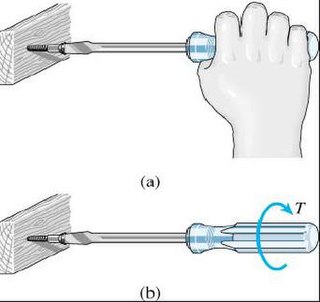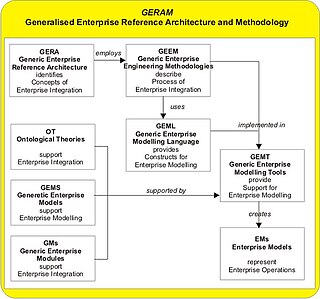
Systems engineering is an interdisciplinary field of engineering and engineering management that focuses on how to design, integrate, and manage complex systems over their life cycles. At its core, systems engineering utilizes systems thinking principles to organize this body of knowledge. The individual outcome of such efforts, an engineered system, can be defined as a combination of components that work in synergy to collectively perform a useful function.
Software design is the process by which an agent creates a specification of a software artifact intended to accomplish goals, using a set of primitive components and subject to constraints. Software design may refer to either "all the activity involved in conceptualizing, framing, implementing, commissioning, and ultimately modifying complex systems" or "the activity following requirements specification and before programming, as ... [in] a stylized software engineering process."

Usability can be described as the capacity of a system to provide a condition for its users to perform the tasks safely, effectively, and efficiently while enjoying the experience. In software engineering, usability is the degree to which a software can be used by specified consumers to achieve quantified objectives with effectiveness, efficiency, and satisfaction in a quantified context of use.
User-centered design (UCD) or user-driven development (UDD) is a framework of process in which usability goals, user characteristics, environment, tasks and workflow of a product, service or process are given extensive attention at each stage of the design process. These tests are conducted with/without actual users during each stage of the process from requirements, pre-production models and post production, completing a circle of proof back to and ensuring that "development proceeds with the user as the center of focus." Such testing is necessary as it is often very difficult for the designers of a product to understand intuitively the first-time users of their design experiences, and what each user's learning curve may look like. User-centered design is based on the understanding of a user, their demands, priorities and experiences and when used, is known to lead to an increased product usefulness and usability as it delivers satisfaction to the user.

In systems engineering and software engineering, requirements analysis focuses on the tasks that determine the needs or conditions to meet the new or altered product or project, taking account of the possibly conflicting requirements of the various stakeholders, analyzing, documenting, validating and managing software or system requirements.

In systems engineering, information systems and software engineering, the systems development life cycle (SDLC), also referred to as the application development life-cycle, is a process for planning, creating, testing, and deploying an information system. The systems development life cycle concept applies to a range of hardware and software configurations, as a system can be composed of hardware only, software only, or a combination of both. There are usually six stages in this cycle: requirement analysis, design, development and testing, implementation, documentation, and evaluation.

In industry, product lifecycle management (PLM) is the process of managing the entire lifecycle of a product from its inception through the engineering, design, and manufacture, as well as the service and disposal of manufactured products. PLM integrates people, data, processes and business systems and provides a product information backbone for companies and their extended enterprise.
Software prototyping is the activity of creating prototypes of software applications, i.e., incomplete versions of the software program being developed. It is an activity that can occur in software development and is comparable to prototyping as known from other fields, such as mechanical engineering or manufacturing.

An accounting as an information system (AIS) is a system of collecting, storing and processing financial and accounting data that are used by decision makers. An accounting information system is generally a computer-based method for tracking accounting activity in conjunction with information technology resources. The resulting financial reports can be used internally by management or externally by other interested parties including investors, creditors and tax authorities. Accounting information systems are designed to support all accounting functions and activities including auditing, financial accounting & reporting, -managerial/ management accounting and tax. The most widely adopted accounting information systems are auditing and financial reporting modules.

The Department of Defense Architecture Framework (DoDAF) is an architecture framework for the United States Department of Defense (DoD) that provides visualization infrastructure for specific stakeholders concerns through viewpoints organized by various views. These views are artifacts for visualizing, understanding, and assimilating the broad scope and complexities of an architecture description through tabular, structural, behavioral, ontological, pictorial, temporal, graphical, probabilistic, or alternative conceptual means. The current release is DoDAF 2.02.
Business analysis is a research discipline of identifying business needs and determining solutions to business problems. Solutions often include a software-systems development component, but may also consist of process improvements, organizational change or strategic planning and policy development. The person who carries out this task is called a business analyst or BA.
Integrated logistic support (ILS) is a technology in the system engineering to lower a product life cycle cost and decrease demand for logistics by the maintenance system optimization to ease the product support. Although originally developed for military purposes, it is also widely used in commercial customer service organisations.
Competence is the set of demonstrable characteristics and skills that enable and improve the efficiency or performance of a job. The term "competence" first appeared in an article authored by R.W. White in 1959 as a concept for performance motivation. In 1970, Craig C. Lundberg defined the concept in "Planning the Executive Development Program". The term gained traction when in 1973, David McClelland wrote a seminal paper entitled, "Testing for Competence Rather Than for Intelligence". It has since been popularized by Richard Boyatzis and many others, such as T.F. Gilbert (1978) who used the concept in relationship to performance improvement. Its use varies widely, which leads to considerable misunderstanding.
Software project management is an art and science of planning and leading software projects. It is a sub-discipline of project management in which software projects are planned, implemented, monitored and controlled.
The Joint Capabilities Integration and Development System (JCIDS), is the formal United States Department of Defense (DoD) process which defines acquisition requirements and evaluation criteria for future defense programs. JCIDS was created to replace the previous service-specific requirements generation system that allowed redundancies in capabilities and failed to meet the combined needs of all US military services. In order to correct these problems, JCIDS is intended to guide the development of requirements for future acquisition systems to reflect the needs of all four services by focusing the requirements generation process on needed capabilities as requested or defined by one of the US combatant commanders. In an ideal implementation of the JCIDS process, regional and functional combatant commanders give early and continuous feedback into the acquisition and sustainment processes to ensure their current and evolving requirements are known and met.
Needs analysis is the formal process that sits alongside Requirements analysis and focuses on the human elements of the requirements.
Competencymanagement systems are usually associated with, and may include, a learning management system (LMS). The LMS is typically a web-based tool that allows access to learning resources. Competency Management Systems tend to have a more multidimensional and comprehensive approach and include tools such as competency management, skills-gap analysis, succession planning, as well as competency analysis and profiling. The CompMS tends to focus more on creating an environment of sustainable competency in addition to entering and tracking learning resources in software. However, conceptually, there is no reason why a CompMS or LMS could not be manual and indeed learning management systems are as old as learning institutions.
The term managerial assessment of proficiency (MAP) describes a methodology for the assessment of managerial competence in human resource and training applications. MAP is designed for evaluation of a manager's proficiency in 12 prescribed competencies, and other criteria. Assessments can be generated for an employee, as well as for a department or the organisation as a whole. Normative values, used for comparative purposes in each assessment, are based upon the performance of over 110,000 managers, across 17 countries, in more than 600 organisations that have used MAP, according to the UK-based company, Development Processes Group plc, that licenses the tool into organisations. The Managerial Assessment of Proficiency - (MAP2), copyright 2012, 2014, HRD Press, Inc. is an assessment tool published by HRD Press, Inc. Amherst, MA USA, and is available throughout the world. "Development Processes Group plc" is the exclusive representative in the United Kingdom.

Generalised Enterprise Reference Architecture and Methodology (GERAM) is a generalised enterprise architecture framework for enterprise integration and business process engineering. It identifies the set of components recommended for use in enterprise engineering.
The term “adaptation” in computer science refers to a process where an interactive system adapts its behaviour to individual users based on information acquired about its user(s) and its environment. Adaptation is one of the three pillars of empiricism in Scrum.







